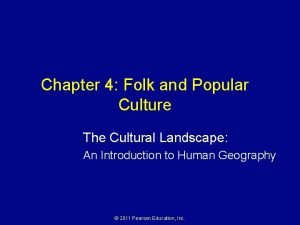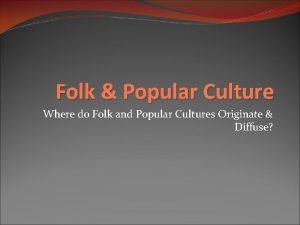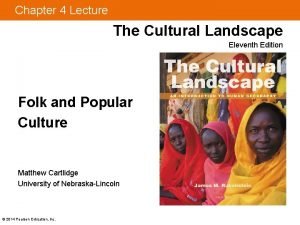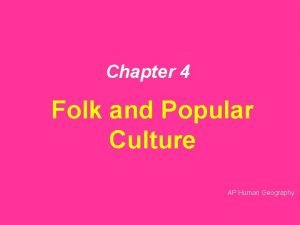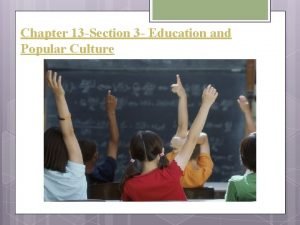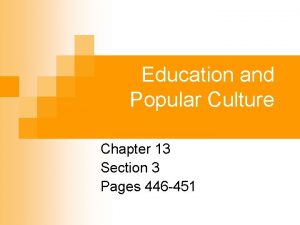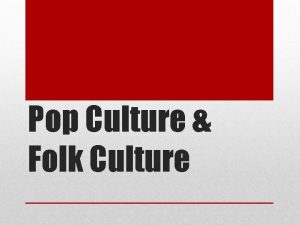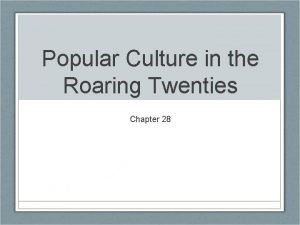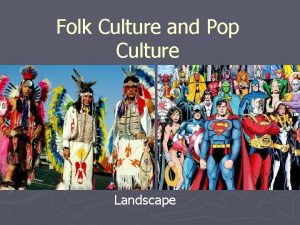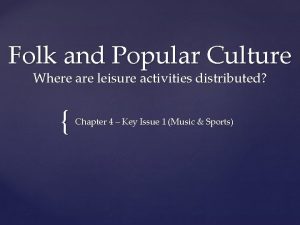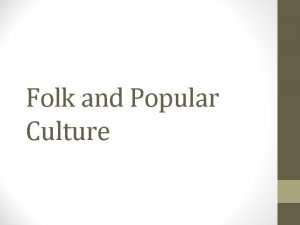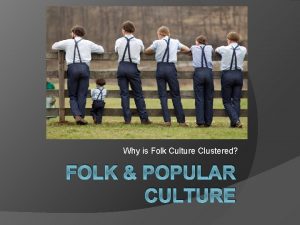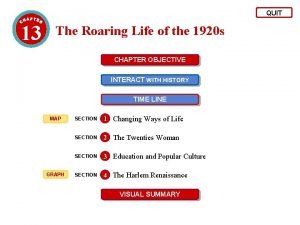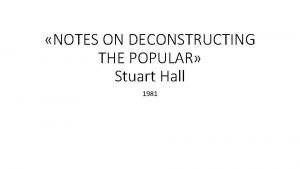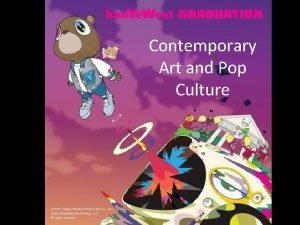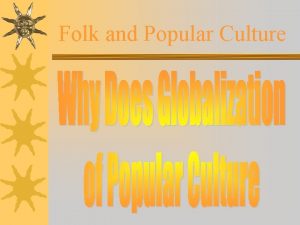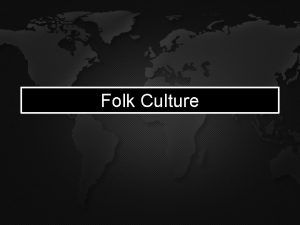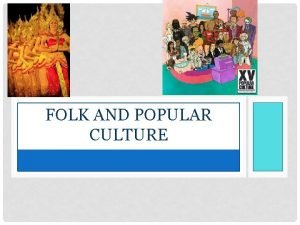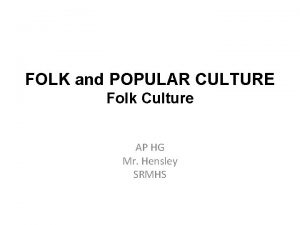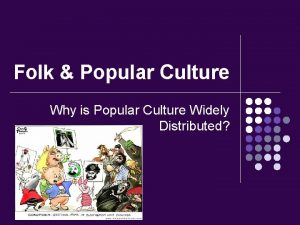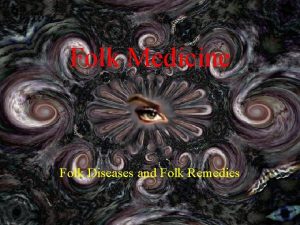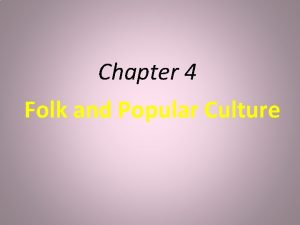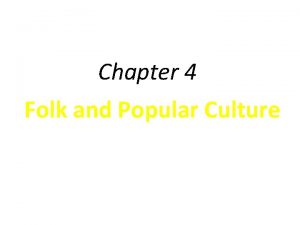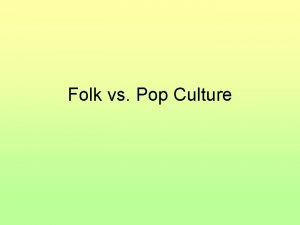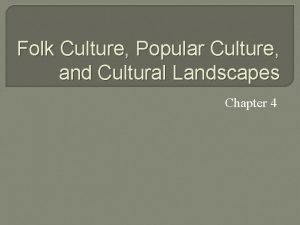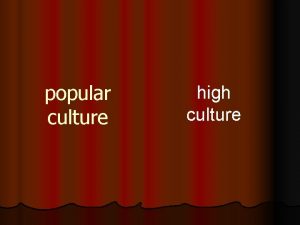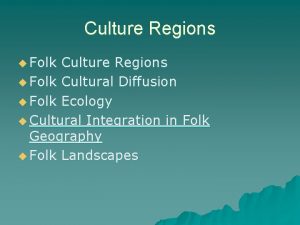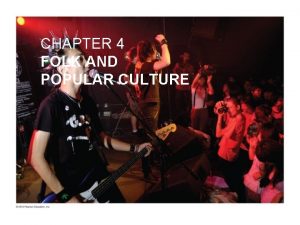Culture Chapter 4 Folk and Popular Culture Chapter




























- Slides: 28

Culture Chapter 4 – Folk and Popular Culture Chapter 5 – Language Chapter 6 – Religion Chapter 7 – Ethnicity Cultural Geography: - A subfield of Geography - focuses upon the patterns and interactions of human culture, both material and non-material. *Carl Sauer. Argued that cultural landscapes should be the focus of human geography.

Unit Objectives Artifact. = Any item, made 1. Identifying and analyzing culture, cultural traits, diffusion, acculturation, by assimilation, humans, that represents and cultural regions. a of culture. 2. material Identifyingaspect and explaining various cultural landscapes and understanding 3. 4. 5. 6. 7. a sense of place Understanding how cultural patterns are represented at various scales from local to global. Understanding the origin and distribution of languages Identifying Universalizing Ethnic Religionsrepetition and recognizing how Customs =andthe frequent of an act, to religions organize space that it becomes characteristic of the extent Understanding the distribution ethnicities, why some group of peopleofperforming the act. have become nationalities. Example: and some current and historical ethnic conflicts. Americans eating turkey on Describing and explaining differences and similarities between world thanksgiving languages, world religions, ethnic groups (ethnicity), and popular/ folk culture. Tradition = A cohesive collection of customs within a cultural group © 2014 Pearson Education, Inc.

What is Culture? • Sum of all the typical activities of a group of people – Cultural Traits: Values, Material items, Political institutions, housing (architecture), religion, transportation, entertainment, art, technology = Cultural Identity Many traits are linked together and affect each other Religion values • Ethnic Group Clothes Food Religion Food Values

How does Culture Change Examples: • Acculturation – the process of the less dominant culture adopting the traits of the more dominate one • Assimilation – when immigrants lose their native customs completely • Transculturation– two-way flow of culture, a merging and converging of cultures

How does Culture Change Examples: • Innovation – new creation/ new ideas that a culture accepts • Diffusion – when an idea or innovation spread from one person or a group to another and is adopted – (remember all the different ways this can spread)

How do we interpret culture Ethnocentrism: • The practice of judging another culture by the standards of one’s own culture Cultural Relativism: • The practice of evaluating a culture by its own standards http: //www. cc. com/video-clips/xer 89 g/thedaily-show-with-jon-stewart-jason-jones-behind-the-veil---ayatollah-you-so

Groupings • Cultural systems – a group of interconnected culture complexes – an area with strong cultural ties that bind people together • Cultural Region – an area marked by culture that distinguishes itself from other regions • Cultural Realm – a large area marked by a number of cultural regions – it is set apart from other world areas b/c of these regions Ethnic Enclaves: An area w/ high ethnic concentrations, characteristic cultural identity & Economic Activity

Habit vs. Custom • Geographers study how culture influences behavior. – Difference between habit and custom • Habit is a repetitive act performed by an individual. – One college student wears jeans with colorful patches. • Custom is a repetitive act performed by a group. – All college students from the American South wear jeans with colorful patches. Habit Custom

4. 1. 1: Compare the origin, diffusion, and distribution of folk and popular culture. Pop VS • Large groups. Culture: of people Popular • The Heterogeneous practice ofgroups • Changes quickly customs that span • Dispersed – Global scale several different – Ex. Wearing jeans, eating fast food, attending sporting cultures events and may have a. Diffusion global • even Hierarchical through major centers i. e. focus NYC, LA, Chicago, London © 2014 Pearson Education, Inc. Folk • • • Culture: Small, Folk isolated groups Homogeneous The practicegroups of Slow to change relatively small group Clustered – local scale of people in a Little interaction w/ others focused area – Ex. Wearing a sari, driving a horse and buggy • Relocation Diffusion Ex: Amish people from PA. to KY.

Diffusion of Pop and Folk Culture is Clustered • Isolation – Tends to lead to cultural diversity – Keeps folk cultures from changing much • Anonymous Hearths, sources, dates • Small Homogenous groups • Dependent on Physical Environment – Limits some choices Folk Culture Belarus people celebrating a festival • Example: Food habits strongly connected to environment REMEMBER POSSIBILISM 1. Some cultures in similar environments have different cultural traits 2. Some cultures in different environments have similar cultural traits (pop culture) © 2014 Pearson Education, Inc. examples of these… Some

Diffusion of Folk Culture Examples - Food customs (repetitive act of a group is a custom) strongly connected to environment Attractions - Slow cook foods = N. Europe - Spicy food = 25˚ around equator Taboos - Religious food taboos (often environmental reasons) - Taking on the phone in the bathroom Different housing styles: combo of social customs & environment © 2014 Pearson Education, Inc. How does physical geography impact local food styles/ regional dishes? How does physical geography impact housing styles?

Worldwide Food Comparison English meat pies & soups Spice Indian curries

Regional Variations in China v regions renowned for their hot climates such as Sichuan and Hunan are also well known for their hot, spicy dishes v Northern China, on the other hand, is known for its noodles, since the primary agricultural product of this region is wheat.

Chinese Food – Dependent on the Physical Environment v The available meat is largely pork, and chicken which can be raised on very little space. – It does not make economic sense to use valuable farmland as grassland for raising beef. – The lack of pasture land for grazing means that there are less milk and dairy products in the Chinese diet. Therefore, they use the soy bean to provide protein and calcium. (adapting to the physical environment)

Religion and City/Town Planning v v New England commons/ greens originally were designed around religious buildings These areas have become public parks/ spaces New Haven Green


Pop Culture • Large, heterogeneous societies that share certain habits • Often the product of economically more developed countries • Largely urban based • Often allowed b/c of industrialization • Based on rapid & simultaneous global connections

Why is Popular Culture Widely Dispersed? • Communication Technology • Travel Technology • Globalization – The process of increased interconnectedness among countries most notably in their economics, politics and culture – Backlash = fundamentalism © 2014 Pearson Education, Inc. • Diffusion of Clothing – Dress = Status/Income – (Folk Culture: Dress = Cultural Group) – Clothing choices NOT environmentally driven • Diffusion of Housing – Housing b/co standard across cultures in MDCs • Cheaper to build • Built by professionals – Housing varies across time NOT space • Diffusion of Food – MDCs consume LOTS of snack foods & alcohol (higher standards of living) – Huge $$$ on advertising to encourage consumption

U. S. House Types (1945– 1990) Popular culture housing varies across TIME not SPACE Modernized traditional dwelling new materials and layout (ex: multi-bedroom, 2 car garage) Modern dwelling advanced technology reflected (ex: most common in US)

• Folk Housing Styles building styles that are particular to the culture of the people who have long inhabited the area; there are three distinct folk-housing regions in the United States – Reflect both cultural and environmental influences – Often based on available resources available Folk Architecture - Varies across SPACE Unchanged – traditional dwelling not altered by external influences ex: some Arab towns Modified traditional dwelling new materials, structure is same ex: change thatch roof to iron (wood, brick, stone, grass & brush…) Nodes New England: Salt Box Two Chimney Cape Cod Front Gable and Wing Middle Atlantic ‘I” Houses (originates as a one-room log cabin) Lower Chesapeake (southern) Steep Roof

US Housing Conclusions • Older houses in the US display local folk cultural traditions • The style of pioneer homes reflected whatever upscale style was prevailing at the place on the East coast from which they migrated • Houses built in the US during the past half century display popular culture influences.


Pop Culture - Housing in popular culture is usually designed by professionals, not by the people who lives in the houses - Popular housing is not limited to locally available building materials - Popular housing styles vary more over time than regionally… for example, houses built in the 1950 s tend to look alike, regardless of where they were built

Where Do Folk Cultures Originate and Diffuse? • Origin of folk music – Folk music characteristics • Tells a story or recounts important life events or activities or customs • Contains important life cycle events (birth, death, marriage) customs • Is personal in nature – – you can learn a lot about a culture from their music © 2014 Pearson Education, Inc.

Where Do Cultures Originate and Diffuse? – Popular music characteristics • Originated around 1900 (tin pan alley) • Written by individuals for the purpose of selling to a large audience • Diffusion began in WW 1 • Highly technical http: //poly-graph. co/labels/ © 2014 Pearson Education, Inc. http: //education. nationalgeographic. com/ne ws/filipino-hip-hop/

Problems Associated w/ Globalization of Popular Culture • Threatens Folk Culture – Muslims view Western dress as a threat • Males lose power over females • Problems of looking “Westernized” – Effect on religious taboos and habits • Less people observe food/clothing restrictions • Negative popular culture transfers (pg. 137) – Increase in prostitution in LDCs – Blood Diamonds (Conflict Diamonds) in Africa • MDCs dominate the media – Over-represents Western ideas – Focus on negative aspects of LDCs(natural disasters) • Creation of a Uniform Landscape © 2014 Pearson Education, Inc.

Problems Cont. • Impact on the Environment – Uniform landscapes = most suburban areas VERY similar (strip malls & housing developments) – Depletion of natural resources • • • Golf courses use up a lot of land (& water) Over-killing of animals for products/ sport (Africa) Eating meat instead of grains – inefficient and expensive; is this suitable for LDCs? ? – Pollution • MDCs create MUCH more waste than LDCs (where folk culture is more prevalent) – (Keep in mind folk cultures also produce waste) © 2014 Pearson Education, Inc.

Religion and City/Town Planning • • New England commons/ greens originally were designed around religious buildings These areas have become public parks/ spaces New Haven Green © 2014 Pearson Education, Inc.
 Folk culture and popular culture venn diagram
Folk culture and popular culture venn diagram Folk cultures are spread primarily by
Folk cultures are spread primarily by Folk culture and popular culture venn diagram
Folk culture and popular culture venn diagram Folk and popular culture
Folk and popular culture Folk culture origins
Folk culture origins Folk and popular culture
Folk and popular culture How do the origins of folk and popular culture differ
How do the origins of folk and popular culture differ How does folk culture diffuse
How does folk culture diffuse Why is access to folk and popular culture unequal
Why is access to folk and popular culture unequal Popular culture ap human geography
Popular culture ap human geography Pop culture origin ap human geography
Pop culture origin ap human geography Chapter 13 section 3 education and popular culture
Chapter 13 section 3 education and popular culture Steamboat willie
Steamboat willie Whats the definition of culture
Whats the definition of culture Chapter 28 popular culture in the roaring twenties
Chapter 28 popular culture in the roaring twenties Chapter 19 section 3 popular culture
Chapter 19 section 3 popular culture Media and popular culture
Media and popular culture 1950s pop culture
1950s pop culture Folk cultural landscape
Folk cultural landscape Where does the 100 take place
Where does the 100 take place Folk culture sports
Folk culture sports Hearth of folk culture
Hearth of folk culture Contrapid
Contrapid Why is folk culture clustered?
Why is folk culture clustered? What is that ?
What is that ? Amish folk culture
Amish folk culture 1920 popular culture
1920 popular culture Stuart hall notes on deconstructing the popular
Stuart hall notes on deconstructing the popular Pop culture themes
Pop culture themes



